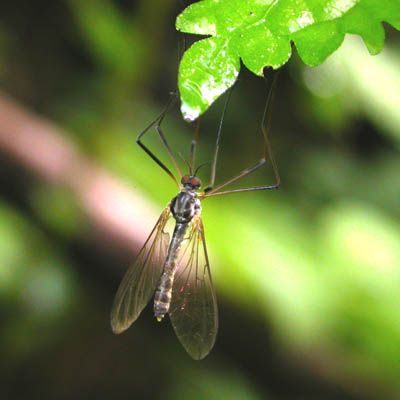Thread subject: Diptera.info :: Images from Japan. Brachycera or Nematocera
Posted by Xespok on 06-10-2005 10:26
#1
Normally I can separate most Diptera to at least these two categories, but with this one I have problems. Unfortunately the image is not fine enough to count the number of antenna segments. The antennae are very long, which hints to Nematocera, the overall structure however suggests Asilidae or Empididae.

Edited by Xespok on 06-10-2005 16:19
Posted by Paul Beuk on 06-10-2005 11:42
#2
Unfortunately I cannot make out the wing venation because the essential part is blotted out by the darker background. Any chance it might be more clearly visible in the original image?
Further, it reminds me of
Trichopeza longicornis of the Empididae but I do not know if that species occurs in Japan or even related genera/species.
Posted by Xespok on 06-10-2005 16:36
#3
This genus does not occur in Honshu.
Based on the database the following genera should occur:
Empidinae: Empis, Rhamphomyia, Hilara, Oreogeton,
Clinocerinae: Trichoclinocera, Acanthoclinocera, Heleodromia, Brachystoma
Hybotinae: Hybos, Syneches, Chillcottomyia,
Ocydromiinae: Bicellaria, Euthyneura, Euthyneura, Leptopeza, Trichina,
Tachydromiinae: Symballophthalmus, \
Hemerodromiinae: Xanthodromia, Chelifera, Dolichocephala
Is this Trichopeza Clinocerinae?
But I think there might be quite a few species of Empididae to be described in Japan.
Posted by Paul Beuk on 06-10-2005 20:28
#4
Of all these genera, the only one I do not really know is
Oreogeton.
Trichopeza is currently placed in the subfamily Trichopezinae and not in Oreogetoninae, though...
Posted by Xespok on 08-10-2005 03:26
#5
Paul,
I forgot to mention that I have another image of this fly, which probably helps you out with the wing venation.
http://xespok.net...dae?page=3
Also, could this fly not belong to Xylophagidae? I have not considered that option yet.
Posted by Paul Beuk on 10-10-2005 08:37
#6
Hmm, no Xylophagidae as far as I can tell, but I cannot really make a good empid of it either. I will get back to this one.
Posted by Xespok on 01-01-2008 19:46
#7
I raise this very old thread, maybe some new eyes can tell us more.
Posted by jorgemotalmeida on 01-01-2008 19:51
#8
it seems an empidoid..
Posted by John Carr on 10-01-2013 00:24
#9
I vote Blephariceridae. (Found this old thread searching on something unrelated.)
Posted by Xespok on 10-01-2013 07:05
#10
Yes, Blephariceridae it will be, possibly Agathon sp. Thanks for solving this old mystery.
Posted by jorgemotalmeida on 27-10-2013 15:56
#11
I agree. It is a Blephariceridae! Great find. And you can see the secondary veins. ;)
